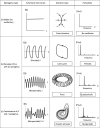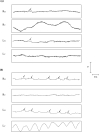Analysing nystagmus waveforms: a computational framework
- PMID: 33963228
- PMCID: PMC8105328
- DOI: 10.1038/s41598-021-89094-7
Analysing nystagmus waveforms: a computational framework
Abstract
We present a new computational approach to analyse nystagmus waveforms. Our framework is designed to fully characterise the state of the nystagmus, aid clinical diagnosis and to quantify the dynamical changes in the oscillations over time. Both linear and nonlinear analyses of time series were used to determine the regularity and complexity of a specific homogenous phenotype of nystagmus. Two-dimensional binocular eye movement recordings were carried out on 5 adult subjects who exhibited a unilateral, uniplanar, vertical nystagmus secondary to a monocular late-onset severe visual loss in the oscillating eye (the Heimann-Bielschowsky Phenomenon). The non-affected eye held a central gaze in both horizontal and vertical planes (± 10 min. of arc). All affected eyes exhibited vertical oscillations, with mean amplitudes and frequencies ranging from 2.0°-4.0° to 0.25-1.5 Hz, respectively. Unstable periodic orbit analysis revealed only 1 subject exhibited a periodic oscillation. The remaining subjects were found to display quasiperiodic (n = 1) and nonperiodic (n = 3) oscillations. Phase space reconstruction allowed attractor identification and the computation of a time series complexity measure-the permutation entropy. The entropy measure was found to be able to distinguish between a periodic oscillation associated with a limit cycle attractor, a quasiperiodic oscillation associated with a torus attractor and nonperiodic oscillations associated with higher-dimensional attractors. Importantly, the permutation entropy was able to rank the oscillations, thereby providing an objective index of nystagmus complexity (range 0.15-0.21) that could not be obtained via unstable periodic orbit analysis or attractor identification alone. These results suggest that our framework provides a comprehensive methodology for characterising nystagmus, aiding differential diagnosis and also permitting investigation of the waveforms over time, thereby facilitating the quantification of future therapeutic managements. In addition, permutation entropy could provide an additional tool for future oculomotor modelling.
Conflict of interest statement
The authors declare no competing interests.
Figures







References
-
- Ditchburn RW. Eye Movements and Visual Perception. Oxford: Clarendon Press; 1973.
-
- Brodsky MC. Pediatric Neuro-Ophthalmology. Berlin: Springer; 2010.
-
- Hertle RW, Dell’Osso LF. Nystagmus in Infancy and Childhood: Current Concepts in Mechanisms, Diagnosis and Management. Oxford: Oxford University Press; 2013.
-
- Leigh RJ, Zee DS. The Neurology of Eye Movements. Oxford: Oxford University Press; 2014.
-
- Bedell HE, Loshin DS. Interrelations between measures of visual acuity and parameters of eye movements in congenital nystagmus. Investig. Ophthalmol. Vis. Sci. 1991;32:416–421. - PubMed
Publication types
LinkOut - more resources
Full Text Sources
Other Literature Sources

